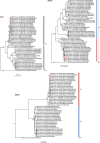Comparative analysis of pentavalent rotavirus vaccine strains and G8 rotaviruses identified during vaccine trial in Africa
- PMID: 26440913
- PMCID: PMC4594120
- DOI: 10.1038/srep14658
Comparative analysis of pentavalent rotavirus vaccine strains and G8 rotaviruses identified during vaccine trial in Africa
Abstract
RotaTeqTM is a pentavalent rotavirus vaccine based on a bovine rotavirus genetic backbone in vitro reassorted with human outer capsid genes. During clinical trials of RotaTeqTM in Sub-Saharan Africa, the vaccine efficacy over a 2-year follow-up was lower against the genotypes contained in the vaccine than against the heterotypic G8P[6] and G8P[1] rotavirus strains of which the former is highly prevalent in Africa. Complete genome analyses of 43 complete rotavirus genomes collected during phase III clinical trials of RotaTeqTM in Sub-Saharan Africa, were conducted to gain insight into the high level of cross-protection afforded by RotaTeqTM against these G8 strains. Phylogenetic analysis revealed the presence of a high number of bovine rotavirus gene segments in these human G8 strains. In addition, we performed an in depth analysis on the individual amino acid level which showed that G8 rotaviruses were more similar to the RotaTeqTM vaccine than non-G8 strains. Because RotaTeqTM possesses a bovine genetic backbone, the high vaccine efficacy against G8 strains might be partially explained by the fact that all these strains contain a complete or partial bovine-like backbone. Altogether, this study supports the hypothesis that gene segments other than VP7 and VP4 play a role in vaccine-induced immunity.
Figures







References
-
- Tate J. E. et al. The WHO-coordinated Global Rotavirus Surveillance Network. 2008 estimate of worldwide rotavirus-associated mortality in children younger than 5 years before the introduction of universal rotavirus vaccination programmes: a systematic review and meta-analysis. Lancet. Infect. Dis. 12, 136–141, 10.1016/S1473-3099(11)70253-5 (2012). - DOI - PubMed
-
- Estes M. & Greenberg H. in Fields Virology (eds Knipe D. M. et al. ) Ch. 45, 1347–1401 (Kluwer Health/Lippincott, Williams and Wilkins, 2013).
Publication types
MeSH terms
Substances
LinkOut - more resources
Full Text Sources
Other Literature Sources
Medical

